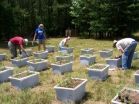(Press-News.org) [Ambulance call-outs and response times in Birmingham and the impact of extreme weather and climate change Online First doi 10.1136/emermed-2012-201817]
Every one degree fall in outside air temperature during the winter corresponds to a drop in ambulance response time of more than 1 per cent, reveals research published online in Emergency Medicine Journal.
Increased demand and treacherous road conditions during the winter months combine to stretch ambulance services in England, which have a target of reaching 75% of immediately life-threatening (category A) calls within eight minutes, say the authors.
Studies on the impact of extreme weather conditions on health have tended to focus on associated illness and death, but there has been relatively little research on the impact of weather on NHS infrastructure in the UK, say the authors.
They therefore looked at how the weather affected daily ambulance call-out and response times in Birmingham, a major conurbation in the Midlands, over a five year period between 2007 and 2011.
This added up to 1705 days and 794,137 emergency calls, of which 282,978 were category A. And it included several weather extremes: the floods of July 2007 and the very cold Decembers of 2009 and 2010.
Their analysis revealed a gradual rise in daily ambulance call-outs from an average of 400 in 2007 to just over 500 in 2011: an increase of 23%.
Both call-out and response times were significantly affected by extremes of weather. Winter was marginally worse for all 36 types of medical condition included in the analysis.
In December 2010, which was the coldest December on record for more than a century, with an average temperature of -1°C, the average daily number of call-outs was 20% higher than in November 2010.
The target ambulance response time fell below 50% three days in a row. Rather than eight minutes, the average time taken to arrive was 15 minutes.
Every 1 degree fall in air temperature corresponded to a 1.3% drop in performance, as call-out volume increased and adverse weather conditions worsened road travel.
"Cold waves" are likely to have as great an impact on ambulance call-out and response times as heat waves, say the authors, who warn that climate change will prompt further temperature extremes.
"The impact of climate change will primarily be seen through more incidents of extreme cold and hot weather, and therefore it will be useful to examine adaption measures such as the use of winter tyres and more flexibility in the number of ambulances available for operation during extreme weather episodes," they write.
"Furthermore, with colder winters and hotter summers, the challenges associated with achieving summer/winter response times, particularly due to increases in call volume, are likely to increase," they warn.
### END
Every degree fall in winter air temperature equals 1 percent drop in ambulance response time
Climate change likely to prompt further extremes of weather and add to pressures
2013-02-28
ELSE PRESS RELEASES FROM THIS DATE:
Discovery opens door to multipronged attack against skin common cancer, Stanford study shows
2013-02-28
STANFORD, Calif. — Hailed as a major step forward in the effort to develop targeted cancer therapies, a recently approved drug for the most common type of skin cancer has been a mixed blessing for patients. Although the initial response is usually dramatic, the tumors often recur as the cancer becomes resistant to treatment.
Now researchers at the Stanford University School of Medicine have identified a second way to block the activity of the signaling cascade, called the Hedgehog pathway, that is abnormally active in these cancers. The researchers hope the new approach ...
Feeding limbs and nervous system of one of Earth's earliest animals discovered
2013-02-28
An extraordinary find allowing scientists to see through the head of the 'fuxianhuiid' arthropod has revealed one of the earliest evolutionary examples of limbs used for feeding, along with the oldest nervous system to stretch beyond the head in fossil record.
Until now, all fossils found of this extremely early soft-bodied animal featured heads covered by a wide shell or 'carapace', obscuring underlying contents from detailed study.
But a new fossil-rich site in South China has been found to contain arthropod examples where the carapace has literally been 'flipped' over ...
What is the cost of rare diseases such as Friedreich's Ataxia?
2013-02-28
What is the cost of rare diseases such as Friedreich's Ataxia? By analyzing direct and indirect costs of care research in BioMed Central's open access journal Orphanet Journal of Rare Diseases calculated that conservatively this rare disease costs between £11,000 and £19,000 per person per year. Proper understanding resource allocation is important in minimizing the effect of Friedreich's Ataxia on people's lives while maximizing their quality of life.
Diseases are classified as 'rare' if they affect less than 1 in 2000 people. Lack of scientific knowledge means that ...
IV fluids used by NHS responsible for unnecessary deaths
2013-02-28
Starch-based intravenous (IV) fluids used by the NHS to treat seriously ill patients are causing unnecessary deaths, according to a new Cochrane systematic review by researchers at the London School of Hygiene & Tropical Medicine.
Based on data from 25 randomised control trials, the researchers concluded that starch-based colloid fluids, used to stabilise patients with low blood pressure, are not only more expensive than saline-based crystalloid fluids, but may also be causing around 250 unnecessary deaths in the UK every year.
The study included 9,147 seriously ill ...
Supermassive black hole spins super-fast
2013-02-28
Imagine a sphere more than 2 million miles across - eight times the distance from Earth to the Moon - spinning so fast that its surface is traveling at nearly the speed of light. Such an object exists: the supermassive black hole at the center of the spiral galaxy NGC 1365.
Astronomers measured its jaw-dropping spin rate using new data from the Nuclear Spectroscopic Telescope Array, or NuSTAR, and the European Space Agency's XMM-Newton X-ray satellites.
"This is the first time anyone has accurately measured the spin of a supermassive black hole," said lead author Guido ...
Silver nanoparticles may adversely affect environment
2013-02-28
DURHAM, N.C. -- In experiments mimicking a natural environment, Duke University researchers have demonstrated that the silver nanoparticles used in many consumer products can have an adverse effect on plants and microorganisms.
Fifty days after scientists applied a single low dose of silver nanoparticles, the experimental environments produced about a third less biomass in some plants and microbes.
These preliminary findings are important, the researchers said, because little is known about the environmental effects of silver nanoparticles, which are found in textiles, ...
Research explores factors that impact adolescent mental health
2013-02-28
Research indicates that half of all lifetime cases of mental illness begin by age 14, well before adulthood. Three new studies investigate the cognitive, genetic and environmental factors that may contribute to mental health disorders in adolescence. The studies are published in Psychological Science and Clinical Psychological Science, journals of the Association for Psychological Science.
Social-Information-Processing Patterns Mediate the Impact of Preventive Intervention on Adolescent Antisocial Behavior
Kenneth A. Dodge, Jennifer Godwin, and The Conduct Problems ...
NuSTAR helps solve riddle of black hole spin
2013-02-28
An international team including Lawrence Livermore National Laboratory scientists has definitively measured the spin rate of a supermassive black hole for the first time.
The findings, made by the two X-ray space observatories, NASA's Nuclear Spectroscopic Telescope Array (NuSTAR) and the European Space Agency's XMM-Newton, solve a long-standing debate about similar measurements in other black holes and will lead to a better understanding of how black holes and galaxies evolve.
"We can trace matter as it swirls into a black hole using X-rays emitted from regions very ...
First grade math skills set foundation for later math ability
2013-02-28
Children who failed to acquire a basic math skill in first grade scored far behind their peers by seventh grade on a test of the mathematical abilities needed to function in adult life, according to researchers supported by the National Institutes of Health.
The basic math skill, number system knowledge, is the ability to relate a quantity to the numerical symbol that represents it, and to manipulate quantities and make calculations. This skill is the basis for all other mathematics abilities, including those necessary for functioning as an adult member of society, a ...
A game plan for climate change
2013-02-28
Researchers have successfully piloted a process that enables natural resource managers to take action to conserve particular wildlife, plants and ecosystems as climate changes.
The Adaptation for Conservation Targets (ACT) framework is a practical approach to assessing how future changes in air and water temperatures, precipitation, stream flows, snowpack, and other environmental conditions might affect natural resources. ACT enables scientists and managers to work hand-in-hand to consider how management actions may need to be adjusted to address those impacts.
"As ...
LAST 30 PRESS RELEASES:
University of Oklahoma researcher awarded funding to pursue AI-powered material design
Exploring how the visual system recovers following injury
Support for parents with infants at pediatric check-ups leads to better reading and math skills in elementary school
Kids’ behavioral health is a growing share of family health costs
Day & night: Cancer disrupts the brain’s natural rhythm
COVID-19 vaccination significantly reduces risk to pregnant women and baby
The role of vaccination in maternal and perinatal outcomes associated with COVID-19 in pregnancy
Mayo Clinic smartwatch system helps parents shorten and defuse children's severe tantrums early
Behavioral health spending spikes to 40% of all children’s health expenditures, nearly doubling in a decade
Digital cognitive behavioral treatment for generalized anxiety disorder
Expenditures for pediatric behavioral health care over time and estimated family financial burden
Air conditioning in nursing homes and mortality during extreme heat
The Alps to lose a record number of glaciers in the next decade
What makes a good proton conductor?
New science reporting guide published for journalists in Bulgaria
New international study reveals major survival gaps among children with cancer
New science reporting guide published for journalists in Turkey
Scientists develop a smarter mRNA therapy that knows which cells to target
Neuroanatomy-informed brain–machine hybrid intelligence for robust acoustic target detection
Eight SwRI hydrogen projects funded by ENERGYWERX
The Lundquist Institute and its start-up company Vitalex Biosciences Announces Strategic Advancement of Second-Generation fungal Vaccine VXV-01 through Phase 1 Trials under $40 Million Competitive Con
Fine particles in pollution are associated with early signs of autoimmune disease
Review article | Towards a Global Ground-Based Earth Observatory (GGBEO): Leveraging existing systems and networks
Penn and UMich create world’s smallest programmable, autonomous robots
Cleveland researchers launch first major study to address ‘hidden performance killer’ in athletes
To connect across politics, try saying what you oppose
Modulating key interaction prevents virus from entering cells
Project explores barriers to NHS career progression facing international medical graduates
Jeonbuk National University researchers explore the impact of different seasonings on the flavor perception of Doenjang soup
Two Keck Medicine of USC Hospitals named Leapfrog Top Teaching Hospitals
[Press-News.org] Every degree fall in winter air temperature equals 1 percent drop in ambulance response timeClimate change likely to prompt further extremes of weather and add to pressures


